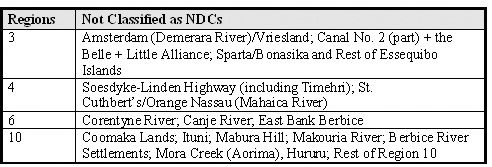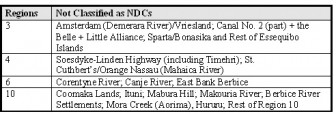Dear Editor,
There is hardly any denial of the under-performance of local government in Guyana, with the oldest municipality in the history of the nation persistently reflecting the depth of its ineffectiveness.
The more recently established Neigbourhood Democratic Councils (NDCs) having no better model, have emulated the failure of the Mayor & City Councillors of Georgetown in the most competitive manner.
A disproportionate percentage of them have mutated into Interim Management Committees (IMCs) – largely dysfunctional, partly because of the limitations of the selectees, and partly because of the non-attendance of under-funded and powerless memberships.
And yet one is in a dilemma to decide whether the fact that this dysfunctionality is limited (according to the last Bureau of Statistics publication) to just 55 NDCs.
See below Table extracted from published statistics.
The residents involved must wonder when ‘local government’ will reach their unorganised communities, if it has not since the above statistics were published. They include the following identifiable areas.
Consideration should also be given to the implications for tax collection in the unorganised areas shown above. The Amerindian communities have certainly moved well ahead.
Suffice it to say that some attempt was however subsequently made to upgrade identified NDCs to municipalities through a donor funded project – Community Services Enhancement Project (CSEP) – the results of which might invite enquiry.
Since the publication of these statistics the Amerindian Act (2006) Cap 29:01 has provided for the incorporation of Amerindian communities to be administered by Village Councils, at least three of whom, on approval of the subject Minister, can be integrated into a District Council. Community Councils established prior to December 31, 2003 may also be recognised by the Minister as such. At the apex of this structure is the National Toshaos Council.
Interestingly there appears to be no comparable formal foregathering of Municipalities or NDCs or both. There was, however, a time when the former had coalesced into a Local Authorities Association which disappeared in direct relation to the decline of its components.
So far as the ‘development’ component is concerned, it remains a puzzle why the position of the ubiquitous Regional Executive Officer (REO) continues to be excluded from the National Budget, particularly with the responsibility assigned to the position for overseeing agriculture, education, health, finance and works – a span of management and control that would appear to exceed that of a single Permanent Secretary, which position, unlike that of the REO, is shown at the top of the 14 grade structure in the Budget.
In the new(?) dispensation it would appear that some satisfaction should be sought regarding the anonymity surrounding this particular appointment, and a comment invited from the Public Service Commission on the process of selection of these ‘public servants.’
Yours faithfully,
E B John








